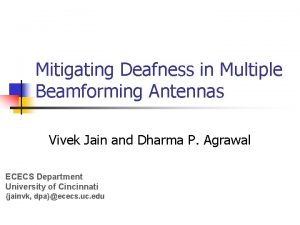Caring to the End Dr Peter Nightingale Royal














- Slides: 14

Caring to the End? Dr Peter Nightingale Royal College of Anaesthetists

Objectives Referral from admission until seen by consultant; Handover and multidisciplinary team working; Levels of supervision; Appropriateness of surgery and anaesthesia; General issues: DVT prophylaxis / access to other facilities and services; § Paediatric practice; § Palliative care in an acute setting. § § § Less than half (1364) were admitted under a surgeon Relatively few (466) underwent a surgical procedure

ASA status Health status on admission n % 1 A normal healthy patient 52 1. 7 2 A patient with mild systemic disease 244 8. 0 3 A patient with severe systemic disease 743 24. 2 4 A patient with incapacitating systemic disease 1368 44. 6 5 A moribund patient 657 21. 4 Subtotal 3064 Not answered Grand Total 89 3153 ASA = American Society of Anesthesiologists 2/3 1/5

ASA, age and urgency of operation Many patients were elderly and in the urgent or immediate category (91% were emergency admissions); both of these factors are associated with an increased mortality

Overall assessment of care The ASA classification does not consider: • patient age, weight, sex and pregnancy; 61% • nature of the planned surgery; • the skill of the anaesthetist or surgeon; • the degree of pre-surgical preparation; or • the facilities for postoperative care.

Adequate time to see the patient? Documented pre-operative anaesthetic review n % Yes 285 68. 8 No 48 11. 6 Unable to answer 81 19. 6 Subtotal 414 Not answered 60 Grand Total 474 Usually elated to urgency of resuscitation and operation

Adequate preoperative optimisation § Generally, adequately prepared (88%) § Reasons for suboptimal state: Ø Ø Ø Investigation of cardiovascular status Fluid balance problems Insertion of central venous line Delay in surgery Lack of an intensive care bed.

Problems with access to facilities § Investigations: echocardiography, CT & ultrasound § Interventions: angiography, cardiac pacing & stenting, nephrostomy, variceal injections § Theatres: emergency lists, recovery staff, clean instruments § Assistance: need for second anaesthetist? § Critical care: HDU and ICU beds

The need for 24/7 services § Service still not delivered by trained doctors § Less trainees in some hospitals Ø Ø Ø Specialist training →General Practice EWTD Covering on-call Commissioning of training § Reconfiguration of acute hospitals? § Residency programmes?

Intra- and post-operative care § Appropriate anaesthetist (96%) Ø Named consultant v In CCT; further Guidance published 2008 § General factors Ø Ø Ø Anaesthetic charts adequate (96%) Monitoring adequate (94%) Patient warming (89%); now embedded in care Airway problems managed appropriately (8. 5%) Postoperative analgesia appropriate (95. 5%)

Paediatric care § Anaesthesia and intensive care medicine Ø Little in this report § Continues to cause problems Ø Ø Ø Lack of paediatric services in many hospitals Loss of expertise Who does the transfer? § Need to review CCT in anaesthesia &ICM?

Palliative care and the ICU § Usually treatment withdrawal on ICU patient § Admission might be appropriate Ø Ø Ø Unable to cope elsewhere in the hospital Family appreciate that ‘all has been done’ May give the family, and others, time to come to terms § ICU staff can provide good end-of-life care Ø Ø Ø Staffing ratio and use of cubicles Used to handling relevant drugs Relatives frequently send letters of thanks

Summary § Assessment, investigation and treatment of surgical emergencies remains problematical Ø Hospitals often not able to provide adequate facilities, especially out of hours § Who is responsible for continuity of care? Ø Training and patient care is affected § 96% anaesthetised by an appropriate grade § Care of sick children remains a problem § The ICU has a role in end-of-life care

 Caring occasion/caring moment
Caring occasion/caring moment Dr peter nightingale
Dr peter nightingale Ode to a nightingale explanation stanza by stanza
Ode to a nightingale explanation stanza by stanza End to end
End to end Front end of compiler
Front end of compiler End to end accounting life cycle tasks
End to end accounting life cycle tasks Stroke volume
Stroke volume Multiple procurement cycles
Multiple procurement cycles Comet nlp
Comet nlp Descendorektostomie
Descendorektostomie End to end delay
End to end delay Stroke volume normal
Stroke volume normal Yichao zhou
Yichao zhou End to end delay
End to end delay Front end and back end in compiler design
Front end and back end in compiler design



























